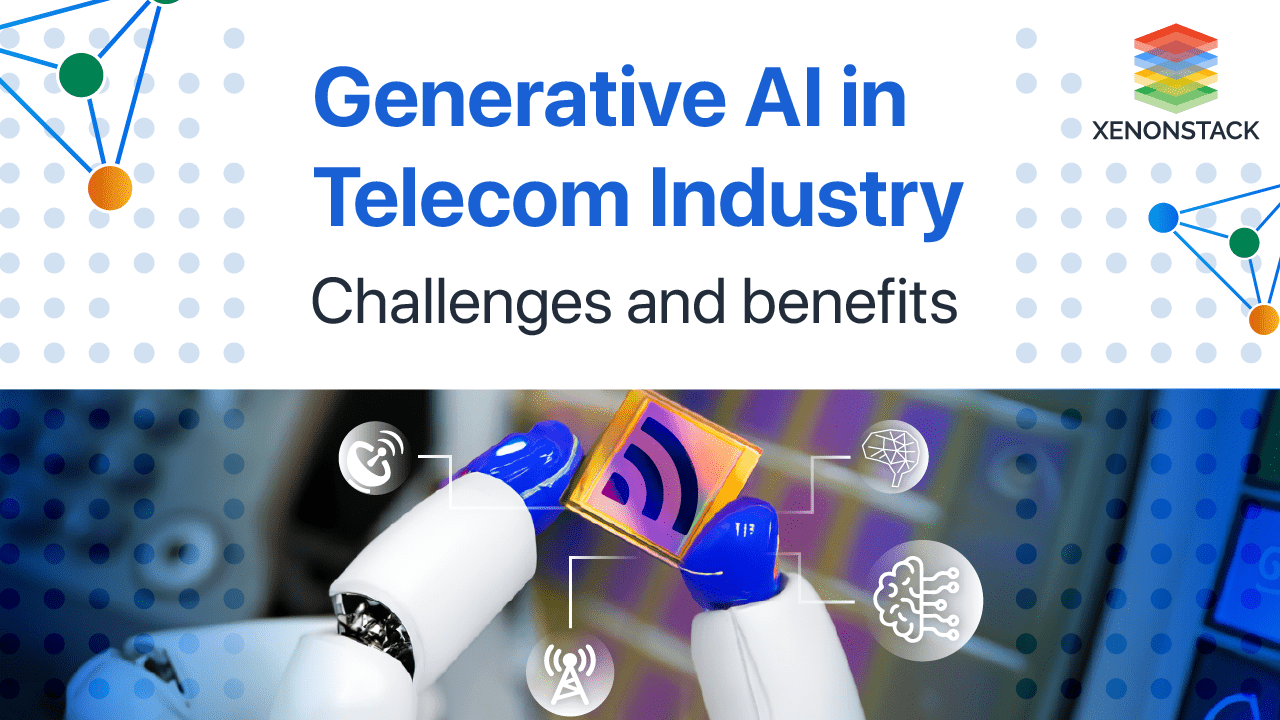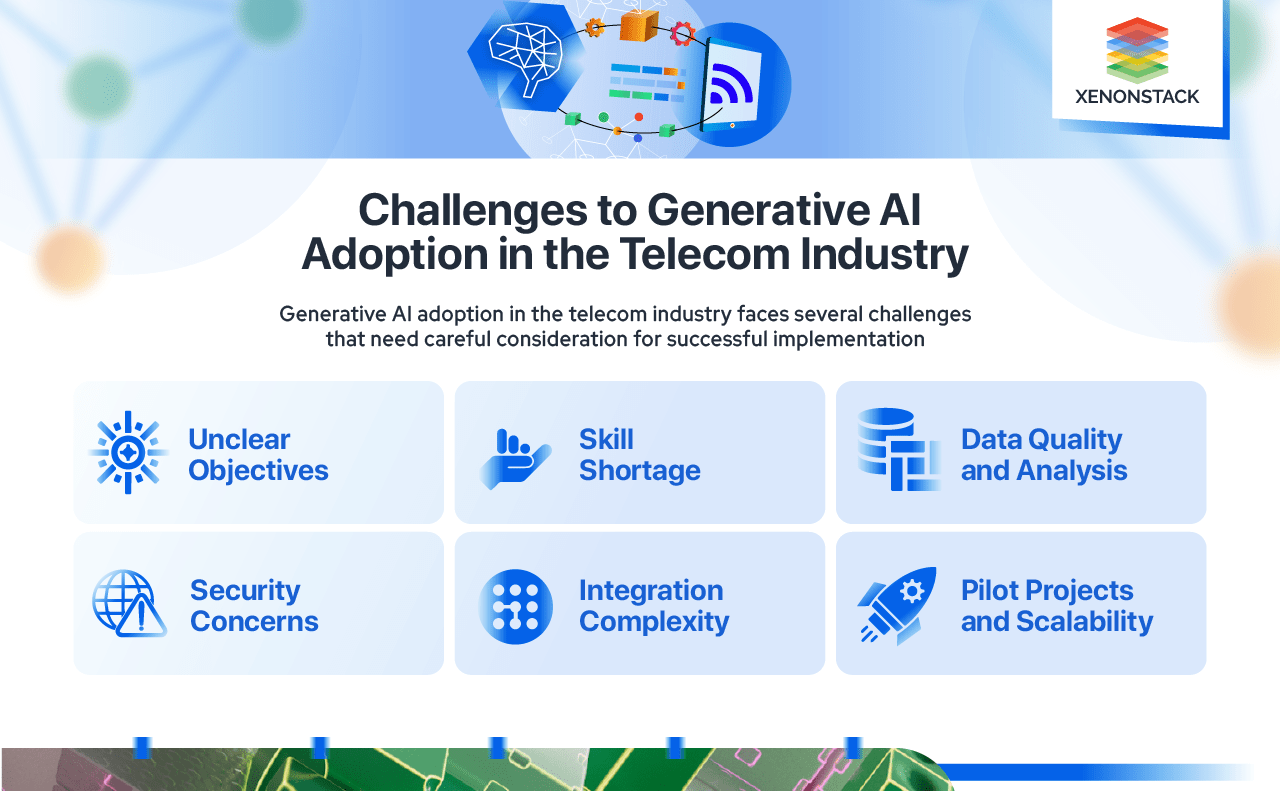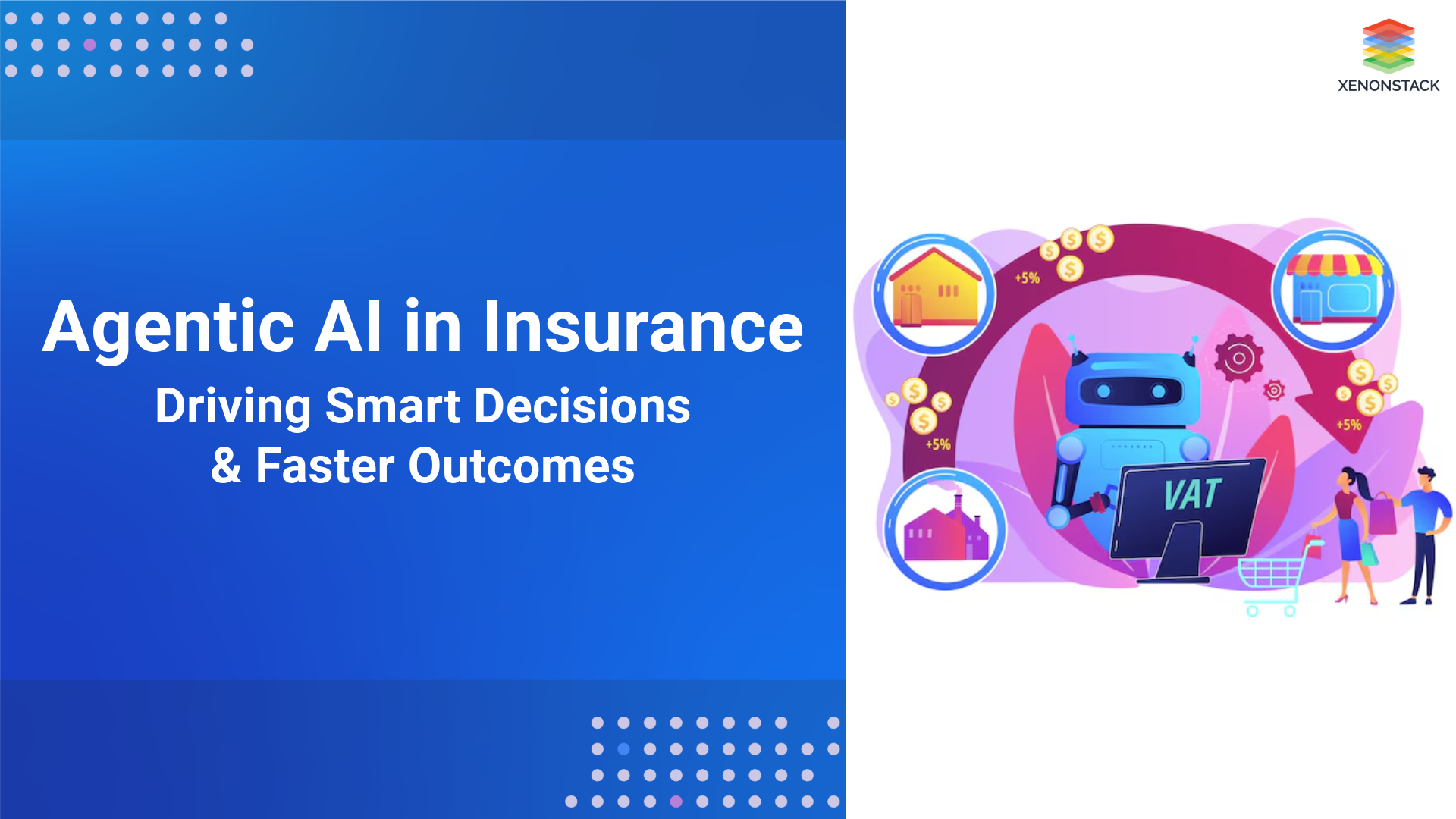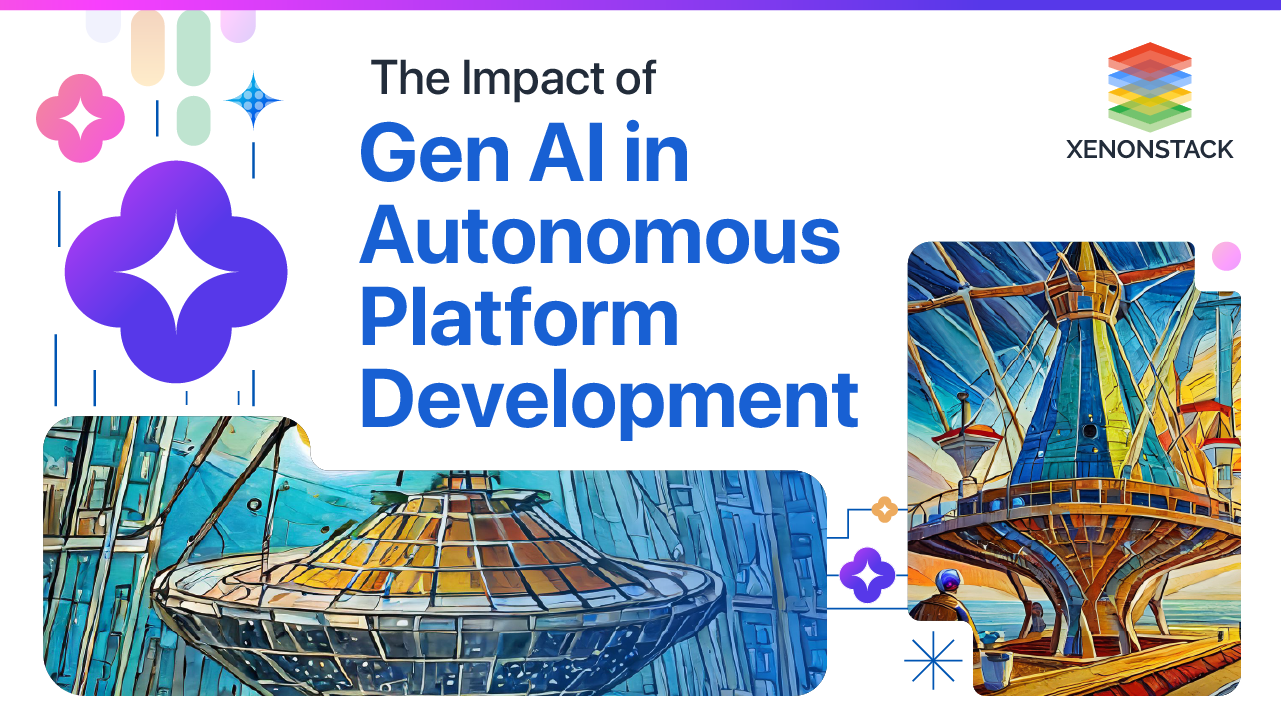
The market for generative artificial intelligence in the telecommunications sector, which amounted to 150.81 million US dollars in 2022, is projected to reach USD 4,883.78 million by 2032 at an annual growth rate of 41.59% from 2023 to 2032. The AI in the telecommunication market has experienced a rapid transformation in recent years, and the advent of artificial intelligence in telecom is set to bring about even more dramatic changes.
What is Generative AI in Telecommunications?
Generative AI is an advanced technology with the potential to transform AI telecommunications operations, customer interactions, and service offerings. By implementing machine learning in telecommunications and AI’s role in network management under telecom, companies can harness the power of innovation, enhance network optimization, and improve customer experiences. This blog post explores telecom and AI, its functionality, and its potential uses in the future of AI in the telecom industry.
Applications of Generative AI in the Telecommunications Industry
Machine learning
Machine learning enables telecom companies to process vast amounts of data, often big data, to generate more practical insights. This technology typically requires human interaction to enhance the system's ability to recognize patterns and execute tasks.
By integrating historical data with future projections, machine learning assists telecom companies in conducting preventive and predictive analytics, allowing them to understand trends better and maintain a competitive edge. For instance, it can analyze customer data to discern usage patterns and more accurately forecast when to enhance service delivery.
Deep learning
Deep learning, a branch of machine learning, involves less human input and employs multilayered neural networks to mimic the intricate decision-making capabilities of the human brain. Telecommunications companies can leverage deep learning to gain deeper insights into their network and customer data.
Generative AI
Generative AI offers several important applications for telecommunications companies, particularly in enhancing customer experience. These technologies enable companies to address customer issues more effectively, create tailored content, and devise strategic improvements. With natural language processing (NLP), gen AI can assist telcos in handling numerous tasks that previously required manual effort.
For instance, they can be used as co-pilots in software development, manage internal knowledge for support teams, and generate and personalize content for marketing and sales departments.
Digital twins
Digital twins are digital models of an object or system designed to enable companies to simulate changes without interrupting service. Many digital twins incorporate real-time data to mirror the actual object or system's performance accurately. Telecommunications companies can utilize digital twins to assess network infrastructure stress and analyze customer usage patterns.
Intelligent automation
Intelligent automation integrates AI, business process management, and Robotic Process Automation (RPA) to enhance and expand decision-making processes within organizations.
Generative AI Use Cases in the Telecom Industry
Generative AI transforms AI telecommunications by revolutionizing operations, customer engagement, and network optimization. Here are the key benefits of using artificial intelligence in telecom:
Network Security and Fraud Mitigation
Description: A proactive and robust approach to safeguarding AI in telecommunication market integrity and mitigating fraudulent activities for seamless and secure connectivity.
Issue/Opportunity: In the ever-evolving landscape of telecom and AI, a proactive and robust approach to safeguarding AI telecom's integrity and mitigating fraudulent activities is imperative for ensuring seamless and secure connectivity.
As networks become increasingly complex and interconnected, the potential vulnerabilities and risks also escalate. Hackers and malicious actors continuously devise sophisticated strategies to exploit weaknesses, threatening artificial intelligence in telecommunication security, data confidentiality, integrity, and availability.
-
Proactive Prevention: Utilizing predictive analysis, Generative AI’s role in network management under telecom assists organizations in foreseeing and proactively mitigating security risks and patterns of fraud. This proactive strategy reduces the chances of security breaches, ensuring that users have a secure and reliable digital experience.
-
Adaptive Security Measure: Hackers constantly evolve tactics, posing challenges to traditional security systems. Generative AI's dynamic adaptation capabilities allow security measures to stay ahead of emerging threats, ensuring ongoing protection for end-users and their data.
-
Fraud Prevention: Generative AI telecom is used to create realistic fraud scenarios that support the development of robust fraud detection systems by utilizing past fraud data. This protects end-users from fraudulent activities in the digital space.
-
Enhanced Threat Detection: Machine learning in telecommunications excels in identifying patterns and anomalies in network optimization, enabling early detection of potential security threats and fraudulent activities. This leads to a more secure environment, safeguarding sensitive information and protecting user data.
-
Reliable System Testing: Generative AI in telco enables the creation of synthetic datasets to test security systems thoroughly. This ensures that security measures are reliable and well-prepared to handle diverse scenarios, contributing to a more resilient and dependable digital infrastructure for end-users.
-
Maintained Data Privacy: Generative AI facilitates the generation of synthetic datasets for testing without compromising real user data. This ensures that the testing processes are conducted in a privacy-preserving manner, aligning with ethical standards and providing users with confidence in the security of their information.
Enhanced customer engagement
Description: Implementation of advanced technologies and customer-centric practices to manage relationships effectively in the AI telecommunications sector.
Issue/opportunity: Telecom companies use AI in telecommunication market data to create personalized and adaptive experiences. This helps them identify and solve problems before they become more significant issues. Reliability and network optimization are key components that telecom firms may deliver while maximizing revenue.
-
Customer Journey Personalization: Generative AI analyses vast datasets to understand individual customer preferences, behaviors, and needs. This information is then utilized to personalize the customer journey, offering tailored services and experiences within the future of AI in the telecom industry.
-
Predictive Analytics: AI telecoms can employ machine learning in telecommunications to predict potential issues or service disruptions before they occur. This proactive approach allows for preemptive problem-solving, reducing downtime and customer frustration.
-
Dynamic Pricing Optimization: AI in telco enables telecom and AI providers to optimize pricing strategies by analyzing market conditions and client usage trends. This ensures that pricing remains reasonable, competitive, and customized to meet individual needs and usage habits.
-
Intelligent Chatbots: Artificial intelligence in telecom powers AI-driven chatbots that offer individualized, real-time customer support. These AI telecommunications chatbots provide instant solutions, understand natural language, and enhance overall customer service.
-
Feedback Analysis: Artificial intelligence in telecommunication processes customer feedback, reviews, and sentiments. Telco AI companies utilize this tool to gain insights into customer satisfaction levels, pinpoint areas for improvement, and proactively enhance service quality.
-
Multi-dimensional Insights: AI’s role in network management under telecom extends to analyzing diverse data sources, providing telecom and AI companies with multi-dimensional insights into customer behaviors and preferences. This comprehensive understanding enables targeted marketing efforts and the development of customer-centric services.
-
Service Quality Optimization: Generative AI optimizes artificial intelligence telecom service quality through continuous monitoring and analysis. It helps identify and address network issues, ensuring customers experience reliable, high-performance AI telecommunications services.
Automated Monitoring Solutions
Description: Leveraging advanced technologies, including generative AI, for continuously monitoring and managing various AI telecommunications network components.
Issue/Opportunity: Automated monitoring solutions in the telecom sector require real-time performance monitoring, fault detection and diagnostics, security monitoring, scalability, predictive analytics, automation of routine tasks, interoperability, customizable alerts and reporting, compliance and reporting, and a user-friendly interface. These ensure efficient, reliable, and proactive AI’s role in network management under telecom, allowing optimal service delivery and minimizing disruptions.
-
Synthetic Data Generation: Generative AI can create synthetic datasets that mimic real-world scenarios, providing diverse data for testing and training automated monitoring systems within the telecom and AI landscape.
-
Signal Enhancement and Noise Reduction: Machine learning in telecommunications enables artificial intelligence in telecommunication models to recognize and filter out noise from signals, improving data transmission quality and aiding in more accurate monitoring.
-
Predictive Analytics: AI telecoms use predictive analytics to anticipate and proactively address potential problems, preventing interruptions and ensuring continuous network monitoring.
-
Anomaly Detection: Generative AI models can learn normal network behavior and generate predictions for expected performance. When anomalies occur, the AI can quickly identify and alert operators for prompt resolution.
-
Content Generation for Reports: Automated monitoring often involves generating reports and insights. Generative AI assists in creating detailed and comprehensible reports, providing valuable insights for network management.
-
Continuous Learning and Adaptation: AI in telecommunication market models continuously learns from fresh data, adapts to evolving network conditions, and improves monitoring accuracy over time, ensuring the future of AI in the telecom industry remains innovative and efficient.
Manage Dynamic Networks - Energy Infrastructure Optimization
Description: Intelligent AI systems are leveraged to optimize energy infrastructure in dynamic networks, improving performance and resource utilization.
Issue/Opportunity: Energy Infrastructure Optimization (EIO) is a set of technologies and strategies designed to improve energy consumption, enhance network optimization, and reduce environmental impacts in the AI in the telecommunication market. This includes intelligent energy management (IEM) systems, energy-efficient network equipment, and real-time energy consumption monitoring and optimization via advanced analytics.
The goal is to balance AI’s role in network management under telecom, operational efficiency, and environmental sustainability while maintaining high-performance connectivity.
-
Churn Prediction: Generative AI can predict potential energy infrastructure issues and proactively address them, minimizing downtime and disruptions in artificial intelligence in telecommunication networks.
-
Hyper-Personalization: AI in telco helps tailor energy optimization strategies to specific telecom and AI network conditions by analyzing machine learning in telecommunications usage patterns and demand variations.
-
New Product and Service Analytics: AI telecoms assist in identifying opportunities for introducing new energy-efficient products and services that align with sustainability goals and the future of AI in the telecom industry.
-
Intelligent Chatbots: AI-driven chatbots can provide real-time information on energy consumption, network status, and network optimization measures, improving user engagement and satisfaction.
-
Customer Retention: By analyzing data, AI in the telecommunication market identifies areas where energy infrastructure improvements can enhance customer experience, leading to better retention rates in AI telecommunications.
-
Advanced Analytics: Generative AI facilitates advanced analytics for ongoing monitoring, identifying trends, and optimizing energy usage in response to changing network dynamics.
Improve Network Performance
Description: Telecommunications network performance is measured by metrics and parameters that evaluate its quality, reliability, and responsiveness in delivering services to users.
Issue/Opportunity: Network Performance management faces challenges such as congestion, scalability, quality of experience, security, technological evolution, dynamic traffic patterns, legacy infrastructure, interoperability, remote network management, and data privacy compliance.
These challenges arise due to the increasing complexity and demands of modern telecommunications networks, including the proliferation of IoT devices and 5G networks and the need to ensure backward compatibility while integrating new technologies.
-
Predictive Analytics: Generative AI predicts congestion, pinpoints vulnerable areas, and foresees equipment failures, allowing operators to take proactive measures to enhance overall AI telecom efficiency.
-
Automated Troubleshooting: Generative AI can be trained to identify patterns associated with common network problems. This enables automated troubleshooting, where the AI system can suggest or implement solutions for issues such as connectivity disruptions, signal degradation, or equipment malfunctions.
-
Dynamic Network Optimization: Gen AI models can dynamically adapt to evolving network conditions in real-time, optimizing parameters by adjusting route configurations, allocating bandwidth on demand, and dynamically optimizing network resources. This ensures the achievement of maximum performance.
-
Security Threat Detection: AI’s role in network management under telecom strengthens security by identifying anomalies that signal threats, unauthorized access, or cyber-attacks. Proactive threat detection provided by AI is instrumental in preventing security breaches and safeguarding the integrity of the network.
-
Resource Allocation: Machine learning in telecommunications enables telecom and AI models to intelligently allocate network resources by optimizing bandwidth distribution, prioritizing critical services, and ensuring effective infrastructure utilization.
-
Capacity Planning: Generative AI helps predict future artificial intelligence in telecom network requirements based on historical data and growth trends. This allows AI telecommunications operators to scale infrastructure efficiently, avoiding congestion and service degradation.
-
Fault Prediction and Prevention: Generative AI predicts potential network infrastructure problems by learning from past incidents. This enables the adoption of precautionary measures to avoid interruptions, reduce downtime, and improve overall network reliability.
-
Network Documentation and Visualization: Generative AI can contribute to creating dynamic network documentation and visual representations. This aids network operators in understanding complex network architectures, identifying bottlenecks, and streamlining decision-making processes.
-
Automation of Repetitive Tasks: In network management, advanced AI intelligence has the potential to liberate time for engaging in more intricate and strategic activities by automating routine or redundant tasks. This encompasses configuration management, regular maintenance, and performance monitoring.
-
Adaptive Learning: The evolution of the network environment allows genetic AI systems to keep learning and adapting. This adaptability is necessary in a rapidly evolving telecommunications environment where new technologies, services, and user behavior continue to determine network requirements.
Network Orchestration
Description: Automated coordination and management of network elements and services ensure efficient operation by integrating and optimizing resources, services, and processes using AI telecommunications solutions.
Issue/Opportunity: Telecom networks face several challenges that require effective network orchestration. These challenges include real-time adaptability, legacy system integration, security concerns, service assurance, complexity in hybrid environments, compliance and regulatory requirements, analytics, and a shortage of human resources. Effective network orchestration must address these challenges to maintain optimal performance and ensure a positive user experience.
-
Automated Network Configuration: Generative AI algorithms can analyze network configurations and automatically generate optimized settings. This streamlines network setup reduces manual errors and improves AI’s role in network management under telecom efficiency.
-
Predictive Analytics: Using machine learning in telecommunications, generative models analyze historical network performance data to predict potential issues or bottlenecks. AI telecommunications orchestration systems proactively optimize resources and prevent service disruptions by foreseeing challenges.
-
Dynamic Resource Allocation: Generative AI enables intelligent algorithms to allocate network resources dynamically based on real-time demands and changing conditions. This ensures optimal resource utilization, minimizes latency, and enhances user experience.
-
Security Response Planning: Artificial intelligence telecom simulates cyber threats and security breaches, allowing operators to create robust response plans. This proactive security approach prevents vulnerabilities before exploitation occurs, reinforcing telecom and AI security frameworks.
-
Service Quality Optimization: Generative AI analyzes patterns of service quality degradation and recommends adjustments to maintain optimal performance. This includes dynamically orchestrating services to meet quality standards and benchmarks for the future of AI in the telecom industry.
-
Intelligent Network Auto-Discovery: Generative models can help automatically discover and map the network topology. This capability is particularly valuable when deploying new devices or services, reducing complexity in network optimization and fault detection.
-
IoT Connectivity Management: In the era of the Internet of Things (IoT), where numerous devices are connected to telecom networks, generative AI can help orchestrate seamless connectivity, ensuring efficient communication between devices and the network.
-
Real-Time Network Inventory Management: Gen AI is capable of playing a role in the dynamic maintenance of network inventories that are constantly updated. It continuously updates and manages the status and location of network assets, thereby enabling the effective utilization of resources.
-
Network Operation Center (NOC) Support: Generative models can assist network operators in decision-making by generating insights and recommendations. This support enhances the capabilities of NOCs to manage and troubleshoot network issues effectively.
- Adaptive Service Orchestration: The future of AI in the telecom industry is shifting towards adaptive service orchestration, where services dynamically adjust based on user demands, environmental conditions, or specific events. Generative AI ensures that networks remain responsive, flexible, and aligned with evolving operational requirements.
Benefits of using AI in Telecommunications
Enhanced Customer Service
By leveraging generative AI, telecom companies can develop advanced platforms that improve customer retention and automate service processes. For instance, T-Mobile's partnership with OpenAI led to the creation of IntentCX, an AI platform designed to enhance customer interactions and provide efficient service solutions.
Network Optimization
Generative AI plays a crucial role in network optimization by analyzing vast amounts of data to predict and mitigate potential issues before they affect customers. This proactive approach ensures a more reliable and efficient network performance.
Personalized Marketing
AI in the telecommunication market enables providers to analyze customer data and deliver personalized marketing campaigns, thereby increasing customer satisfaction and driving revenue growth.
Operational Efficiency
By automating routine tasks and optimizing resource allocation, AI telecommunications enhances operational efficiency within telecom organizations. This includes intelligent automation of network operations and predictive maintenance, leading to cost savings and improved service delivery.
Challenges of Generative AI Adoption in the Telecom Industry

Generative AI adoption in the telecom industry faces several challenges that need careful consideration for successful implementation:
- Unclear Objectives: Defining clear and measurable objectives for AI initiatives is crucial. Telecom companies may encounter challenges aligning AI efforts with business goals, emphasizing the need for well-defined objectives to measure success.
- Skill Shortage: Successfully implementing generative AI is challenging due to the need for more proficient AI professionals. To overcome this obstacle, it is crucial to invest in training programs and recruit data science experts, as this will aid in bridging the skill gap within the industry.
- Data Quality and Analysis: Generative AI is intricately dependent on data. Ensuring data quality and implementing resilient data analysis practices are imperative for effectively utilizing AI in telecommunications.
- Security Concerns: Ensuring security and privacy, building customer trust, and complying with regulations are crucial for successful AI adoption in telecom.
- Integration Complexity: Integrating generative AI into existing systems can be complex. Adopting a modular approach and ensuring compatibility with current infrastructure can streamline the integration process.
- Pilot Projects and Scalability: Starting with smaller pilot projects allows telecom companies to test the feasibility of generative AI before scaling up. This approach helps mitigate risks and ensures a more effective and controlled adoption process.
- Cultivating Innovation Culture: Fostering an innovation-friendly culture within the organization is crucial. Encouraging employees to adapt to new technologies and fostering an environment conducive to AI adoption can contribute to successful implementation.
Future Trends in AI Telecommunications
Integration of AI in Network Management
The future of AI in the telecom industry involves deeper integration of AI technologies into network management systems. This includes the development of self-optimizing networks that can autonomously adjust parameters to maintain optimal performance.
Expansion of AI Services
Telecom companies are expected to broaden their AI-driven service offerings, such as AI-powered customer support and advanced analytics services, to enhance customer experience and open new revenue streams.
AI-Driven Network Security
As networks become more complex, AI telecoms will play a pivotal role in identifying and mitigating security threats in real-time, ensuring robust protection against cyberattacks.
Adoption of Generative AI for Content Creation
Generative AI will be increasingly utilized to create personalized content and services, enhancing user engagement and satisfaction.
How Gen AI Reshaping the Telecom Industry
Generative AI is transforming the telecom industry. It offers a range of applications, including personalized content creation, efficient network optimization, improved customer service, and predictive maintenance enhancement. By partnering with a generative AI development company, telecom businesses can confidently leverage this technology's full potential and navigate the dynamic landscape. Adopting generative AI solutions allows the telecommunications industry to embark on a path of innovation and excellence, reshaping its prospects.
Next Steps with Generative AI in the Telecom Industry
Connect with our experts to explore implementing advanced AI systems and how the telecom industry leverages Decision Intelligence and Generative AI to become more decision-centric. Harness AI to automate and optimize telecom operations, enhance customer experience, and improve efficiency and responsiveness.





